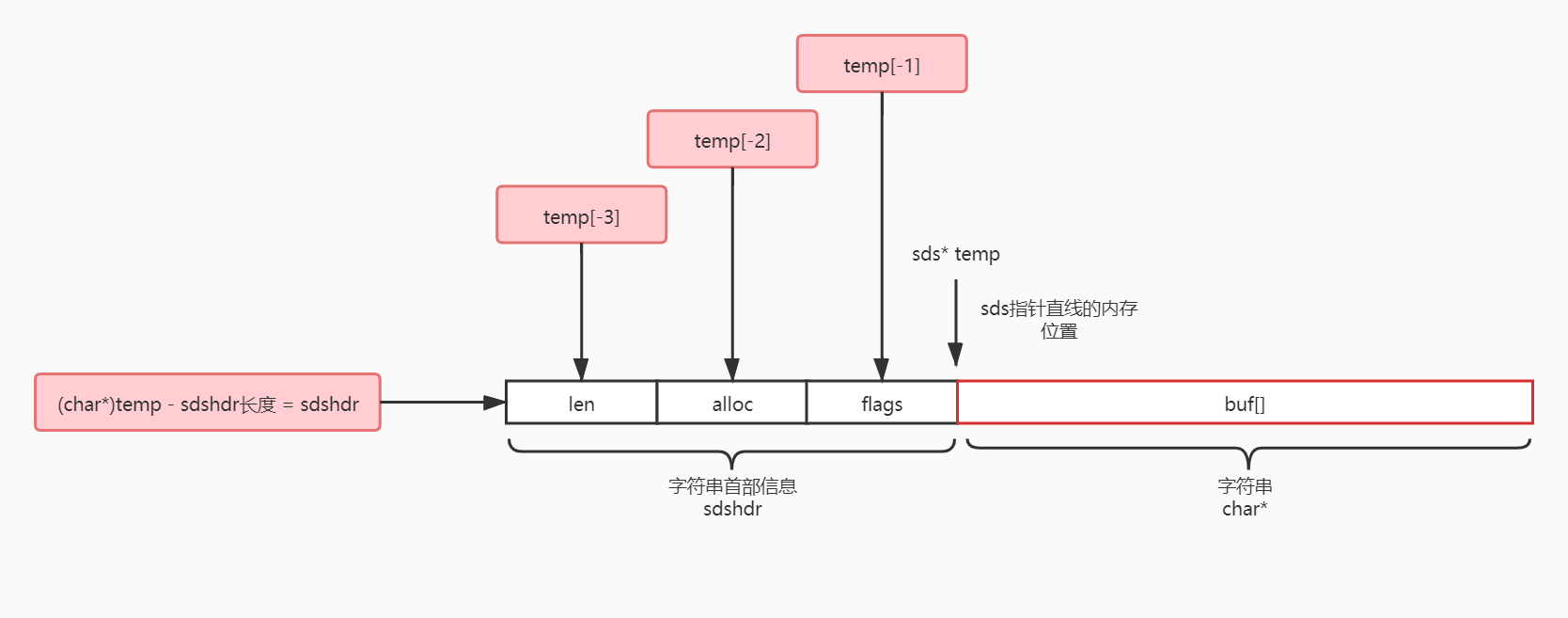数据结构00-动态字符串-sds
数据结构00-动态字符串-sds
数据结构
在3.2版本之前,动态字符串的结构是这样的。
struct sdshdr {
// buf数组的长度
unsigned int len;
// buf数组还剩空间
unsigned int free;
char buf[];
};
在3.2版本,redis对sds进行了内存占用优化,结构改成了这样。没错,会根据字符串的长度对于不同的结构体。
/* Note: sdshdr5 is never used, we just access the flags byte directly.
* However is here to document the layout of type 5 SDS strings. */
struct __attribute__ ((__packed__)) sdshdr5 {
unsigned char flags; /* 3 lsb of type, and 5 msb of string length */
char buf[];
};
struct __attribute__ ((__packed__)) sdshdr8 {
uint8_t len; /* used */
uint8_t alloc; /* excluding the header and null terminator */
unsigned char flags; /* 3 lsb of type, 5 unused bits */
char buf[];
};
struct __attribute__ ((__packed__)) sdshdr16 {
uint16_t len; /* used */
uint16_t alloc; /* excluding the header and null terminator */
unsigned char flags; /* 3 lsb of type, 5 unused bits */
char buf[];
};
struct __attribute__ ((__packed__)) sdshdr32 {
uint32_t len; /* used */
uint32_t alloc; /* excluding the header and null terminator */
unsigned char flags; /* 3 lsb of type, 5 unused bits */
char buf[];
};
struct __attribute__ ((__packed__)) sdshdr64 {
uint64_t len; /* used */
uint64_t alloc; /* excluding the header and null terminator */
unsigned char flags; /* 3 lsb of type, 5 unused bits */
char buf[];
};
__attribute__ ((__packed__))是编译器特性,作用是取消内存对齐我们可以先忽略。简化一下如下
/* 长度小于32(1<<5)使用这个结构体,用户创建字符串不会使用这个结构体,直接使用sdsdhr8
sdshdr5会在内部的一些地方使用,比如key
*/
struct sdshdr5 {
unsigned char flags; /* 低3位存储类型, 高5位存储字符串长度 */
char buf[];
};
/* 长度小于256(1<<8)使用这个结构体 */
struct sdshdr8 {
uint8_t len; /* buf已使用长度 */
uint8_t alloc; /* buf字节数,不包括最后的'\0',buf[]的字节数 = alloc + 1 */
unsigned char flags; /* 低3位存储类型, 高5位未使用 */
char buf[];
};
/* 长度小于65536(1<<16)使用这个结构体 */
struct sdshdr16 {
uint16_t len; /* buf已使用长度 */
uint16_t alloc; /* buf字节数,不包括最后的'\0',buf[]的字节数 = alloc + 1 */
unsigned char flags; /* 低3位存储类型, 高5位未使用 */
char buf[];
};
/* 长度小于4,294,967,296(1<<32)使用这个结构体 */
struct sdshdr32 {
uint32_t len; /* buf已使用长度 */
uint32_t alloc; /* buf字节数,不包括最后的'\0',buf[]的字节数 = alloc + 1 */
unsigned char flags; /* 低3位存储类型, 高5位未使用 */
char buf[];
};
/* 长度小于18,446,744,073,709,551,616(1<<64)使用这个结构体,但是redis中的字符串占用内存限制在
512M,所以没用用到这个结构体
*/
struct sdshdr64 {
uint64_t len; /* buf已使用长度 */
uint64_t alloc; /* buf字节数,不包括最后的'\0',buf[]的字节数 = alloc + 1 */
unsigned char flags; /* 低3位存储类型, 高5位未使用 */
char buf[];
};
可以看出3.2版本之前,len和free都是unsigned int,各占4个字节。在3.2版本之后,按不同长度分了5种结构体,sdshdr8与旧版的sdshdr就差了8(4 * 2)个字节,内存占用更少了。
巧妙的设计
复用标准库函数
对外使用的数据结构还是一个sds,是char*的别名,结构如下
typedef char *sds;
是一个 char 指针,能兼容使用c语言标准库中的函数,但与一般的 char 真正不一样的是,sds 是带有头信息的,也就是各种 sdshdr,这里涉及C指针的知识,指针[-1]能获取上一个内存位置的字段。

获取头信息的方式,sds[-1]获取flags(类型),通过 flags 获取到真实的 sdshdr,计算出 sdshdr 数据结构的长度x,sds的指针地址 - x 就是sdshdr。
位存储
unsigned char flags;标志字段,这里的设计也比较巧妙,在比较看重内存的程序中都会有这样子的设计出现,unsigned char代表一个字节,也就是8位。为什么使用3位就能标识5种结构体呢,我们看下源码中的定义
#define SDS_TYPE_5 0
#define SDS_TYPE_8 1
#define SDS_TYPE_16 2
#define SDS_TYPE_32 3
#define SDS_TYPE_64 4
#define SDS_TYPE_MASK 7
5、8、16、32、64的结构体分别对应数字0、1、2、3、4,在二进制中,三个bit的排列组合如下
000 --- SDS_TYPE_5
001 --- SDS_TYPE_8
010 --- SDS_TYPE_16
011 --- SDS_TYPE_32
100 --- SDS_TYPE_64
111 --- SDS_TYPE_MASK
还有101、110、111未使用
用3个bits就能表示8种状态,如果使用8个char类型的话就需要64bits的内存空间。
SDS_TYPE_MASK是掩码,flags & SDS_TYPE_MASK就是类型编码
容量扩容策略
扩容关键代码:
sds sdsMakeRoomFor(sds s, size_t addlen) {
void *sh, *newsh;
/* 可用空间 */
size_t avail = sdsavail(s);
/* 长度 */
size_t len, newlen;
/* 获取类型 */
char type, oldtype = s[-1] & SDS_TYPE_MASK;
int hdrlen;
size_t usable;
/* Return ASAP if there is enough space left. */
/* 如果可用空间>=需要添加的空间,直接返回 */
if (avail >= addlen) return s;
len = sdslen(s);
/* sh是sds 首部(hdr)信息的指针地址 */
sh = (char*)s-sdsHdrSize(oldtype);
/* 计算新的长度 */
newlen = (len+addlen);
assert(newlen > len); /* Catch size_t overflow */
/* 新的长度小于 1024*1024(1M)的话,扩容到新的长度的两倍 */
if (newlen < SDS_MAX_PREALLOC)
newlen *= 2;
else
/* 新的长度大于等于 1024*1024(1M)的话,新的长度加上 1024*1024(1M) */
newlen += SDS_MAX_PREALLOC;
/* 通过新的长度获取类型 */
type = sdsReqType(newlen);
/* Don't use type 5: the user is appending to the string and type 5 is
* not able to remember empty space, so sdsMakeRoomFor() must be called
* at every appending operation. */
/* 这里把SDS_TYPE_5转成SDS_TYPE_8,原因是type 5的数据结构没有记录剩余的空间,
* 如果扩容需要更多的操作
* */
if (type == SDS_TYPE_5) type = SDS_TYPE_8;
/* 计算首部长度 */
hdrlen = sdsHdrSize(type);
assert(hdrlen + newlen + 1 > len); /* Catch size_t overflow */
/* 旧的类型与新的类型一致 */
if (oldtype==type) {
/* 因为类型一致,扩容后把旧的sh复制到新的内存空间中 */
newsh = s_realloc_usable(sh, hdrlen+newlen+1, &usable);
if (newsh == NULL) return NULL;
/* 首部地址 + 首部的长度 = char* */
s = (char*)newsh+hdrlen;
} else {
/* Since the header size changes, need to move the string forward,
* and can't use realloc */
/* 类型不一致,重新分配一个sh */
newsh = s_malloc_usable(hdrlen+newlen+1, &usable);
if (newsh == NULL) return NULL;
/* 把char*复制到新的内存空间中 */
memcpy((char*)newsh+hdrlen, s, len+1);
/* 把旧的释放 */
s_free(sh);
/* 首部地址 + 首部的长度 = char* */
s = (char*)newsh+hdrlen;
/* 设置类型 */
s[-1] = type;
/* 设置长度 */
sdssetlen(s, len);
}
/* 可用空间 = 总空间 - 首部长度 - 1,-1的原因是char*尾部会追加一个'\0',需要把这个去掉 */
usable = usable-hdrlen-1;
if (usable > sdsTypeMaxSize(type))
usable = sdsTypeMaxSize(type);
/* 设置可用空间,alloc的单位是Byte */
sdssetalloc(s, usable);
return s;
}
如果新的长度小于1M,扩容到新的长度的两倍,新的长度大于等于1M的话,新的长度加上1M。就是长度大于等于1M之后,1M递增。
例子:
- newLen = 50,根据上面的算法,newLen = newLen * 2,结果是100
- newLen = (1024 * 1024),根据上面的算法,newLen = newLen + (1024 * 1024),结果是(1024 * 1024) + (1024 * 1024)
优点:
- 预分配内存,减少内存重新分配,提升性能
缺点:
- 需要更多的内存
容量缩容策略
sds sdsRemoveFreeSpace(sds s) {
void *sh, *newsh;
char type, oldtype = s[-1] & SDS_TYPE_MASK;
int hdrlen, oldhdrlen = sdsHdrSize(oldtype);
size_t len = sdslen(s);
size_t avail = sdsavail(s);
sh = (char*)s-oldhdrlen;
/* Return ASAP if there is no space left. */
if (avail == 0) return s;
/* Check what would be the minimum SDS header that is just good enough to
* fit this string. */
type = sdsReqType(len);
hdrlen = sdsHdrSize(type);
/* If the type is the same, or at least a large enough type is still
* required, we just realloc(), letting the allocator to do the copy
* only if really needed. Otherwise if the change is huge, we manually
* reallocate the string to use the different header type. */
if (oldtype==type || type > SDS_TYPE_8) {
newsh = s_realloc(sh, oldhdrlen+len+1);
if (newsh == NULL) return NULL;
s = (char*)newsh+oldhdrlen;
} else {
newsh = s_malloc(hdrlen+len+1);
if (newsh == NULL) return NULL;
memcpy((char*)newsh+hdrlen, s, len+1);
s_free(sh);
s = (char*)newsh+hdrlen;
s[-1] = type;
sdssetlen(s, len);
}
sdssetalloc(s, len);
return s;
}
缩容的关键代码和扩容的代码差不多,都是相同类型的话,申请一块新的内存空间,把旧的所有内容复制过去,不一致的话,申请一块内存空间,重新赋值长度、类型、可用空间,把char*复制过去。
sds长度缩小的函数:
- sdstrim
- sdssubstr
- sdsrange
- sdsclear
在这些函数中,sds的长度减小了,但是不会实时收缩buff[]的长度,buff的缩小有专门的函数sdsRemoveFreeSpace,调用这个函数才会真实地缩小buff的长度,惰性释放。字符串缩容在对外部使用的字符串并不会使用,而是在内部调用,比如发送给服务端的命令参数。
